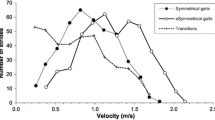Summary
The locomotor activity of Sciurus vulgaris has been observed in the field and in caged animals.
Onset and cessation of activity (data from the cage only): Activity starts before sunrise and correlation with sunrise is very high (0.838≤r≤0.990). Cessation of activity normally lies before sunset, during summer late in the afternoon, in winter often already before noon. It is scatterd to a greater extent than onset of activity, correlation with sunset being 0.535≤r ≤0.798.
Daily pattern: It is a bigeminus, although widely subject to seasonal variations. The afternoon peak is lacking from November till February, begins to form in March and reaches as much as 33.5% of total activity in September. The pause occurring at noon is most distinct during summer and vanishes gradually during the autumn months. Data from the field and from the cage show essentially the same pattern.
Annual pattern: In the cage, activity is least during winter, increases gradually to a maximum in September followed by a sharp decrease to the winter minimum. The curve derived from the field observations shows a bimodal shape with a first peak in April and a second, more distinct one in September. A combination of the two groups of data shows three phases: December to May with irregular variations, May to September showing a conspicuous increase to maximal activity, September to December with sharp decrease to the winter minimum.
Zusammenfassung
Die lokomotorische Aktivität von Sciurus vulgaris im Freiland und im Käfig wurde untersucht.
Aktivitätsbeginn und-ende (nur Käfigbeobachtungen): Der Aktivitätsbeginn liegt kurz vor Sonnenaufgang und ist eng damit korreliert (0,838≤r≤0,990). Das Aktivitätsende erfolgt meist vor Sonnenuntergang, im Sommer am späten Nachmittag, im Winter oft schon vor Mittag, und zeigt eine sehr große Streuung. Korrelation Aktivitätsende — Sonnenuntergang 0.535≤r≤0,798.
Tagesmuster der Aktivität: Es ist ein Bigeminus, der allerdings starken saisonalen Schwankungen unterworfen ist. Das Nebenmaximum fehlt von November bis Februar, entsteht ab März und macht im September 33,5% der Gesamtaktivität aus. Die mittägliche Ruhepause ist im Sommer am deutlichsten und verschwindet im Herbst sukzessive. Freiland- und Käfigbeobachtungen ergaben im wesentlichen das gleiche Bild.
Jahresperiodik: Im Käfig ist die Aktivität im Winter am geringsten, steigt allmählich bis zu einem Maximum im September und fällt dann sehr rasch ab. Im Freiland läßt sich ein zweigipfliger Kurvenverlauf erkennen mit einem ersten Maximum im April und einem zweiten, deutlicheren im September. Eine Zusammenfassung von Käfig- und Freilandergebnissen läßt drei Phasen erkennen: Dezember bis Mai mit starken Schwankungen, Mai bis September mit deutlichem Anstieg zum Herbstmaximum, September bis Dezember mit steilem Absinken der Aktivitätskurve auf das winterliche Tief.
Similar content being viewed by others
Literatur
Aschoff, J.: Aktivitätsmuster der Tagesperiodik. Die Naturwissenschaften 44, 361–367 (1957)
Aschoff, J.: Spontane lokomotorische Aktivität. In: W. Kükenthal, Handbuch der Zoologie, Bd. 8, S. 30. Berlin: De Gruyter 1962
Baumann, F.: Die freilebenden Säugetiere der Schweiz, Bern: Huber 1949
Briedermann, L.: Zum Ablauf der sommerlichen Aktivitätsperiodik des Gamswildes (Rupicapra r. rupicapra L. 1758) in freier Wildbahn. Der zool. Garten (NF) 33, 279–305 (1967)
Clarkson, D. P., Ferguson, H. J.: Effect of temperature upon activity in the red squirrel. Amer. zool. 9, 1110 (Abstract) (1969)
Degn, H. J.: Feeding activity in the red squirrel (Sciurus vulgaris). J. Zool. Lond. 174, 516–520 (1974)
Eibl-Eibesfeldt, I.: Beobachtungen zur Fortpflanzungsbiologie und Jugendentwicklung des Eichhörnchens (Sciurus vulgaris L.). Z. Tierpsychol. 8, 370–400 (1951)
Graefe, G.: Die Aktivitätsperiodik des Flughörnchens (Glaucomys volans Linnaeus 1758) und des Backenhörnchens (Tamias striatus Linnaeus 1758). Z. Tierpsychol. 18, 84–90 (1961)
Gundlach, H.: Tagesperiodik und Verhalten beim Wildschwein (Sus scrofa). In: G. Birukow, L. Rensing, eds., Biologische Rhythmen. Nachrichten der Akademie der Wissenschaften in Göttingen, math.-physik. Klasse, Nr. 10, 120 (1967)
Hediger, H.: Zur Biologie des Eichhörnchens. Rev. Suisse Zool. 52, 361–370 (1945)
Hicks, E. A.: Ecological factors affecting the activity of the western fox squirrel, Sciurus niger rufiventer. Ecol. Monogr. 19, 287–302 (1949)
Holler, N. R., Marsden, H. M.: Onset of evening activity of swamp rabbits and cottontails in relation to sunset. J. Wildl. Manage. 34, 349–353 (1970)
Layne, J. N.: The biology of the red squirrel, Tamiasciurus hudsonicus loquax (Bangs) in central New York. Ecol. Monogr. 24, 227–267 (1954)
Pengelley, E. T., Asmundson, S. J.: Annual biological clocks. Scientific American 224, 72–79 (1971)
Pulliainen, E.: Winter ecology of the red squirrel (Sciurus vulgaris L.) in northeastern Lapland. Ann. Zool. Fenn. 10, 487–494 (1973)
Saint Girons, M.-Ch.: Le rhythme circadien de l'activité chez les mammifères holarctiques. Mémoires du Muséum d'Histoire Naturelle Série A, Zoologie, tome XL, fasc. 3, 101–187 (1966)
Shaw, W. T.: Seasonal and daily activities of the Columbian ground squirrel at Pullman, Washington. Ecology 26, 74–84 (1945)
Short, H. L., Duke, W. B.: Seasonal food consumption and body weights of captive tree squirrels. J. Wildl. Manage. 35, 435–439 (1971)
Shorten, M.: Squirrels, their biology and control. Ministry of agriculture, fisheries and food, London, Bulletin No. 184 (1962)
Zwahlen, R.: Zur Fortpflanzung und Jugendentwicklung des Eichhörnchens, Sciurus vulgaris (Linné 1758). Säugetierk. Mitt. 23, 9–13 (1975)
Zwahlen, R.: Ein Beitrag zur Ernährungsökologie und zum Schadverhalten des Eichhörnchens. Jahrb. Nat. Hist. Mus. Bern (im Druck)
Author information
Authors and Affiliations
Rights and permissions
About this article
Cite this article
Zwahlen, R. Die lokomotorische Aktivität des Eichhörnchens (Sciurus vulgaris). Oecologia 22, 79–98 (1975). https://doi.org/10.1007/BF00345260
Received:
Issue Date:
DOI: https://doi.org/10.1007/BF00345260




